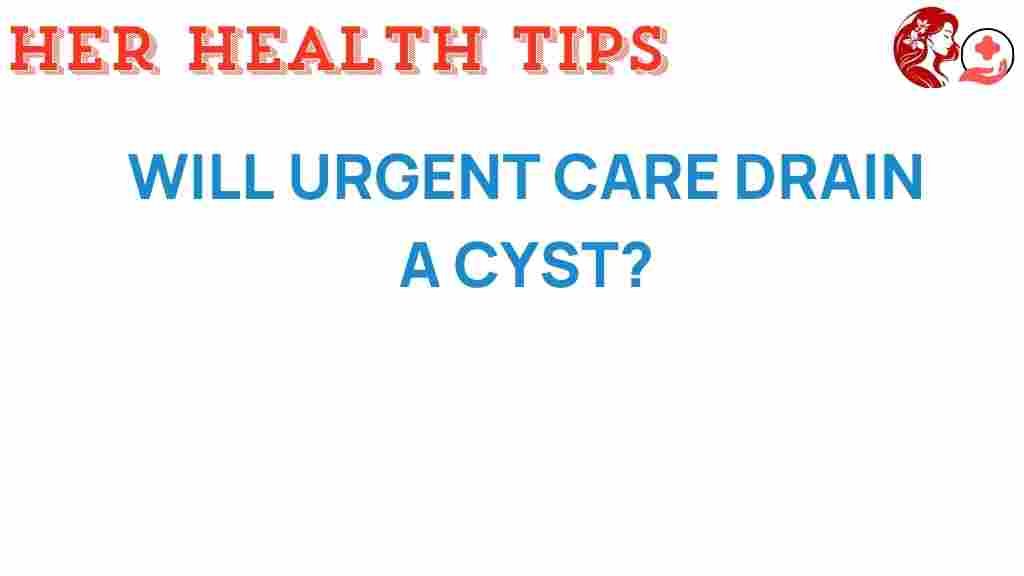Can Urgent Care Effectively Drain a Cyst? What You Need to Know
Cysts are fluid-filled sacs that can form in various parts of the body, and while many are harmless, they can sometimes cause discomfort or lead to other health concerns. When faced with a cyst that requires drainage, patients often wonder if they should seek treatment at an urgent care facility. In this article, we will explore the role of urgent care in cyst drainage, the medical procedures involved, and important considerations for patients.
Understanding Cysts and When to Seek Treatment
A cyst can develop for various reasons, including infection, clogged sebaceous glands, or as a result of trauma. While most cysts are benign, they can sometimes become painful or infected, leading to the need for treatment.
Here are some common types of cysts:
- Sebaceous cysts: Formed from clogged sebaceous glands, often on the scalp, face, or neck.
- Ganglion cysts: Usually found on wrists or hands, these cysts are filled with a jelly-like fluid.
- Dermoid cysts: Typically present at birth, these can contain hair, skin, or teeth.
- Breast cysts: Fluid-filled sacs that can develop in breast tissue.
If you notice a cyst that is growing, painful, or showing signs of infection (such as redness, warmth, or pus), it is important to seek medical attention. Urgent care can be a suitable option for cyst drainage in many situations.
Urgent Care and Cyst Drainage
When considering urgent care for cyst drainage, it is essential to understand the capabilities of these facilities. Urgent care centers are designed to handle non-life-threatening emergencies and provide immediate care for various health concerns, including minor surgical procedures such as cyst drainage.
Here’s what you need to know about the process:
1. Initial Assessment
Upon arrival at an urgent care facility, a healthcare provider will conduct an initial assessment. This may include:
- Reviewing your medical history
- Performing a physical examination of the cyst
- Determining if drainage is necessary
2. Preparation for Drainage
If the healthcare provider determines that cyst drainage is necessary, they will prepare you for the procedure. This usually involves:
- Cleaning the area around the cyst
- Administering a local anesthetic to numb the area
- Explaining the procedure and addressing any patient concerns
3. Performing the Drainage
The actual cyst drainage procedure typically includes the following steps:
- Making a small incision in the cyst (if necessary)
- Draining the fluid from the cyst
- Cleaning the area again to prevent infection
- Applying a bandage or dressing to the site
4. Post-Procedure Care
After the procedure, you will receive instructions for caring for the site, which may include:
- Keeping the area clean and dry
- Watching for signs of infection, such as increased redness or pus
- Taking prescribed antibiotics (if necessary)
- Follow-up visits if the cyst recurs or does not heal properly
Advantages of Using Urgent Care for Cyst Drainage
Choosing urgent care for cyst drainage can be beneficial for several reasons:
- Accessibility: Urgent care centers often have flexible hours and can see patients without an appointment.
- Cost-Effective: Treatment at urgent care can be more affordable than visiting an emergency room.
- Immediate Care: Patients do not have to wait long for treatment, which is crucial for painful or infected cysts.
Potential Risks and Considerations
While urgent care can effectively drain a cyst, there are some risks and considerations to keep in mind:
- Infection: As with any procedure that breaks the skin, there is a risk of infection.
- Recurrence: Cysts can sometimes refill with fluid even after drainage.
- Complications: Rarely, complications such as excessive bleeding or allergic reactions to anesthetics may occur.
It is crucial to discuss these risks with the healthcare provider at the urgent care center to ensure you are fully informed before proceeding.
Troubleshooting Tips Post-Drainage
After cyst drainage, monitoring the site is essential for a smooth recovery. Here are some troubleshooting tips:
- Watch for Infection: Monitor for symptoms like increased swelling, redness, warmth, or discharge. If any of these occur, contact your healthcare provider immediately.
- Pain Management: Over-the-counter pain relievers can help manage discomfort, but always follow the dosage instructions.
- Follow-Up Care: Schedule any necessary follow-up appointments to ensure proper healing.
When to Consider Other Treatment Options
While urgent care can handle many cyst drainage cases, there are situations where other treatment options may be necessary:
- Large or Complex Cysts: If the cyst is exceptionally large or has unusual characteristics, a specialist may need to evaluate it.
- Recurrent Cysts: If you have a history of recurring cysts, further evaluation may be needed to determine the underlying cause.
- Associated Symptoms: If the cyst is accompanied by severe pain, fever, or other concerning symptoms, seek emergency services for a comprehensive assessment.
In these cases, a referral to a dermatologist or surgeon may be appropriate for further evaluation and treatment.
Conclusion
Urgent care facilities offer a practical option for patients needing cyst drainage, providing accessible and immediate care for this common health concern. With proper assessment, preparation, and post-procedure care, many patients can achieve satisfactory outcomes. However, it’s essential to be aware of the potential risks and to seek further treatment if complications arise.
If you’re experiencing a cyst that may need drainage, consider visiting your local urgent care center. For more information on healthcare services, you can visit this resource.
Remember, your health is a priority. Don’t hesitate to seek medical attention when necessary.
For more insights on health concerns and urgent care services, feel free to explore our other articles on patient care.
This article is in the category Conditions and created by HerHealthTips Team
